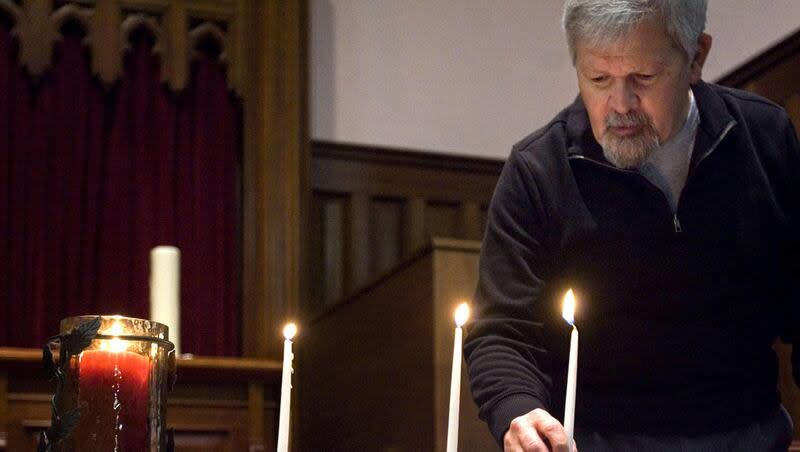Opinion: How much compensation is enough for downwinders?

- Oops!Something went wrong.Please try again later.
It’s hardly news that persistent aboveground nuclear testing in the mid-20th century spread fallout far and wide. That is one clear case where what happened near Las Vegas has not stayed there.
The question that won’t go away, however, is what we should do about it. It’s a question looming large right now.
Nearly 80 years ago, workers at the Kodak Company in Rochester, New York, were among the first to discover widespread fallout after customers complained that sensitive X-ray film was contaminated with fogging.
According to the Museum of Radiation and Radioactivity, one of these workers, a physicist named J.H. Webb, traced the contamination to cardboard the company had sourced from Indiana as packing material. This, he finally concluded, came from the Trinity Test, the first nuclear explosion, which took place in Alamogordo, New Mexico, on July 16, 1945. The fallout had reached the river that was used to manufacture the cardboard pulp.
Indiana isn’t exactly next door to New Mexico.
Today, this conclusion is a tiny fraction of the evidence that shows the government’s tests between 1945 and 1962, many in Nevada, did more than contaminate just a small portion of southern Utah. The federal government conducted 215 aboveground tests in various places, beginning with Trinity in 1945, while often telling nearby residents there was no danger.
Other countries conducted similar tests around the globe.
In 1990, Congress passed a bill known as the Radiation Exposure Compensation Act, or RECA, which provided compensation for some of the people affected by these tests. The rules are strict. For Utahns to qualify for $50,000, they must have lived in certain counties in Nevada, Arizona or Utah for two consecutive years from 1951 to 1962, and must have contracted one of a list of cancers. People who worked in uranium extraction in several states from 1942 to 1971 and who had specific types of cancer are eligible for $100,000. Workers at testing facilities also qualify for $75,000.
But this law is set to expire June 10.
Sen. Josh Hawley, R-Mo., is sponsoring a bill that would expand compensation and greatly widen the net. People who meet the criteria in all of Utah, plus Arizona, Colorado, Idaho, Montana, Nevada, New Mexico and Guam, would also qualify.
The bill already passed the Senate in a bipartisan vote, but without the support of Utah’s Mike Lee or Mitt Romney. Instead, they are supporting a separate bill that, according to The Hill, would simply extend the current RECA bill for another two years.
The Hill quoted Romney as saying Hawley’s bill would cost $50 billion, which is far more than a simple extension of the law.
On the other side, Utah Gov. Spencer Cox has come out in favor of the expanded bill. His office sent me a statement saying, “We support efforts to expand compensation for those affected by the nuclear testing that occurred throughout the West. It’s the right thing to do.”
Meanwhile, the evidence mounts. A study by several scientists last year concluded that fallout from the Trinity test alone reached 46 states, Mexico and Canada within 10 days. They also studied the effects of 93 aboveground tests conducted in Nevada and found evidence of radiation in all 48 contiguous states.
The New York Times said the researchers were helped by the release of data from Europe charting weather patterns up to 30,000 feet in elevation dating back to 1940.
Certainly, lines must be drawn somewhere. Also, cost should be a consideration, as should strict eligibility requirements. The government can’t simply write blank checks to anyone who makes a claim.
But that’s not likely to happen here. In fact, it has never been easy to prove a claim.
A federal report on compensation said the current law has dispersed $2.6 billion over 30 years to 40,258 people, or 75% of those who applied.
As author and activist Mary Dickson, herself a victim, told me, few victims remain alive, and still fewer realize they are eligible for compensation. It’s hard to prove you lived in the right place more than 60 years ago and had the right kind of cancer. She believes the $50 billion estimate is far too high.
She also told the Deseret News editorial board last year that recent lobbying visits to Washington have left her “shocked by how many of them (lawmakers) don’t even know our nuclear past.” Ignorance is spreading as the past fades.
And yet that past, important though it was for the defense of freedom, is not pretty. A nation should not be able to sicken and kill its own people without being held accountable.

